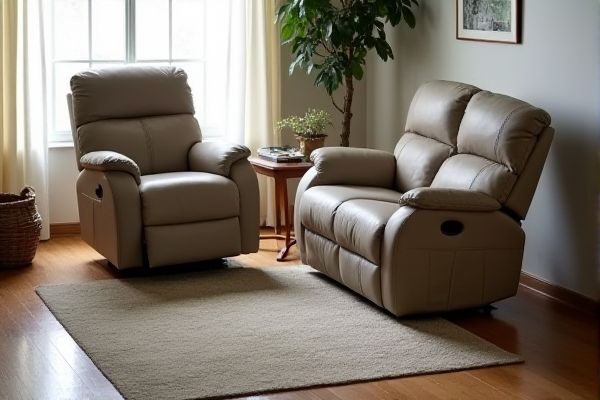
Electric recliners offer effortless adjustment with the push of a button, providing enhanced comfort and convenience compared to manual recliners that require physical effort to change positions. Explore the rest of the article to discover which recliner best suits your lifestyle and comfort needs.
Table of Comparison
| Feature | Electric Recliner | Manual Recliner |
|---|---|---|
| Operation | Powered by electric motor, controlled with buttons or remote | Mechanically adjusted using a lever or push-back mechanism |
| Ease of Use | Effortless, suitable for all mobility levels | Requires physical effort to recline and return |
| Price Range | Higher cost, typically $400 - $1500+ | Lower cost, typically $150 - $700 |
| Maintenance | Requires electrical components upkeep | Minimal maintenance, mostly mechanical parts |
| Customization | Multiple recline positions and features (e.g. massage, heat) | Limited positions, usually two or three preset angles |
| Power Dependency | Requires electrical power supply | Does not require electricity |
| Weight | Generally heavier due to motors and wiring | Lighter and easier to move |
| Suitability | Ideal for seniors, disabled, or comfort seekers | Good for budget-conscious and physically able users |
Introduction to Electric vs Manual Recliners
Electric recliners offer effortless adjustment with motorized controls, providing customizable comfort and ease of use, ideal for individuals with limited mobility. Manual recliners rely on physical effort to change positions, often featuring a lever or push-back mechanism, making them a more affordable and simple option. Your choice depends on the importance of convenience, budget, and the level of personalized comfort you desire in a recliner.
Key Differences Between Electric and Manual Recliners
Electric recliners feature motorized mechanisms controlled by buttons or remotes, offering effortless adjustment and customizable positions for enhanced comfort. Manual recliners require physical effort through levers or handles to recline, making them simpler and typically more affordable. Electric models often include advanced features like USB ports and massage functions, whereas manual recliners prioritize durability and ease of maintenance.
Comfort and Ease of Use
Electric recliners provide superior comfort and ease of use by allowing you to adjust positions smoothly with minimal effort via remote controls, ideal for those with limited mobility. Manual recliners require physical effort to operate, which can be less convenient and tiring, especially when frequent adjustments are needed. Your choice impacts relaxation quality, as electric models often offer precise positioning for optimal ergonomic support.
Design and Customization Options
Electric recliners offer advanced design features with customizable settings such as adjustable headrests, lumbar support, and multiple reclining positions controlled via remote or smartphone app. Manual recliners provide simplicity and durability, often featuring straightforward lever or push-back mechanisms with limited customization options. Electric models support personalized comfort and ergonomic adjustments, while manual recliners emphasize ease of use and cost-effectiveness.
Installation and Space Requirements
Electric recliners typically require a nearby power outlet and slightly more space behind the chair to accommodate the motor and reclining mechanism, making installation a bit more involved than manual recliners. Manual recliners have simpler installation needs with no electrical setup and generally need less clearance space, ideal for compact rooms. Your choice should factor in the availability of power sources and the room size to ensure optimal comfort and functionality.
Durability and Maintenance
Electric recliners often feature complex mechanical components and motors, which may require more frequent maintenance and potential repairs compared to manual recliners. Manual recliners, with simpler mechanisms, generally offer greater durability and easier upkeep over time due to fewer parts prone to malfunction. Choosing a recliner depends on balancing convenience with long-term reliability and maintenance costs.
Energy Consumption and Cost
Electric recliners consume more energy due to their motorized components, leading to slightly higher electricity costs compared to manual recliners, which require no power source. The initial purchase price of electric recliners is typically higher, reflecting the advanced technology and convenience features, while manual recliners offer a more budget-friendly option with minimal maintenance expenses. Your choice between these types depends on balancing ongoing energy costs with upfront investment and personal comfort preferences.
Safety Features and Accessibility
Electric recliners offer enhanced safety features such as built-in sensors to prevent pinching and automatic shut-off mechanisms that reduce the risk of overheating, making them suitable for users with limited mobility or seniors. Manual recliners rely on mechanical levers and require physical effort, which may pose challenges for individuals with arthritis or limited strength, potentially increasing the risk of falls or strain injuries. Accessibility is significantly improved with electric recliners due to remote control operation and adjustable settings, providing greater ease of use and independence for people with disabilities or mobility impairments.
User Preferences and Lifestyle Considerations
Electric recliners offer effortless adjustment with the push of a button, ideal for users seeking convenience and enhanced comfort, especially those with mobility challenges or frequent use. Manual recliners provide greater control over reclining angles and often appeal to those preferring simplicity and a more affordable option that fits various lifestyles. Your choice should reflect how often you plan to use the recliner and whether ease of operation or traditional manual control better suits your daily routine and physical needs.
Which Recliner is Right for You?
Electric recliners offer effortless adjustment with the push of a button, ideal for those seeking convenience and precise positioning to enhance comfort and support. Manual recliners rely on physical effort, making them durable and typically more affordable, suitable for individuals who prefer simplicity and traditional functionality. Your choice depends on whether you prioritize ease of use and customizable comfort or prefer cost-effective, straightforward operation.
 homyna.com
homyna.com